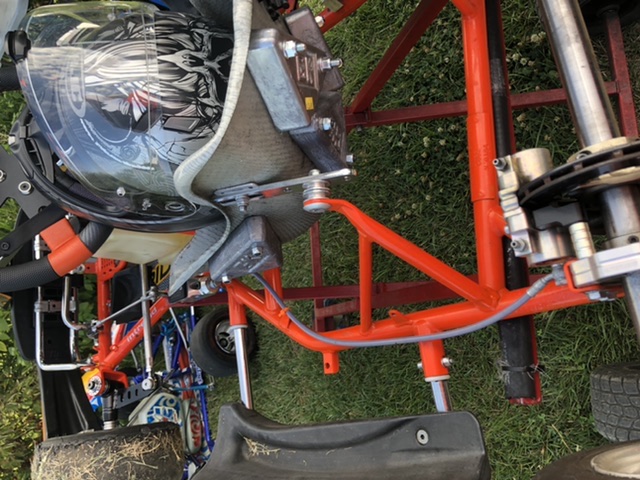I got a question I just got my kart in today. I took it out of the box but I noticed there is no place to add weight. Do you mount the weight to the seat or close to the tires. If both then does that mean I got to weld a rod on the kart, or drill holes in the seat. How is this done. I know I have seen a lot guys drill wholes in the seat. I’m not wanting to weld on the chassis the heat can cause it to bend.
Almost all your weight will go on the seat. Depending on what class you’re running, placement may vary, but most weight ends up on the back and sides of the seat. You can also mount on the front fork where the steering shaft slots in. Some guys will clamp weight onto the frame rails, but I would advise against that for most cases.
A kart works with a combination of mechanical weight jacking and frame flex. So you want to mount the weight where it will be effective in helping the kart flex properly.
For sprint karts, the general ranges on distribution % is around 40-44% front weight, and 50/50 side-to-side.
Oh ok I see now. That’s good because I was not sure. I got to weight around 365 for the lo206 right. That’s kart and driver with gas if I’m not mistaken.
Here is an example of my sons kart. We were running out of real estate to hang the  weight. I hope he gained weight over the winter.
weight. I hope he gained weight over the winter.
Make sure you have sufficiently strong bolts and large washers on them as well. Your club may even have rules regarding the attachment of lead.
I see you put weight all over the seat. Is there a reason for that. Like to try to balance out the kart. Or you just had no where else to hang the weight. Because TJ said you got to have 50/50 side to side, and 40/44 front to back. Also is the 44% for the front or the back.
Each class has a minimum weight so you may have to add weight to meet that. Generally you’ll add weight to the left side of the seat to offset the weight of the engine. Generally people don’t weld brackets on or add anything to the chassis since it may bind the chassis up and not cause it not to flex and ruin the handling.
40-44% on the front. 42-43 is a good starting point.
Lead is surprisingly pricey. Is there a less toxic alternative?
Here is something I have been keeping for a long time that might point you in the right direction.
Osmium! Sadly it’s over 400 bucks a pound!
Bismuth is the closest thing you’ll get to lead at a cheap price.
Thanks. That is good to know.
This is all I use when I reload my ammo be it shotgun, or handgun, and rifle bullets.
In addition to adding weight to the kart, does anyone ever use a weight vest? Is that allowed? Would there be advantages to it (being able to move the weight around)?
My son and I are just getting started, and we’re both very light in our classes. To make weight, we’ll each have to add 60+ pounds to each of our karts.
Generally weight vests are not legal in sprint karting. Weights must be secured to the kart. Dirt or oval karting is a little more lax on this subject… When I ran the dirt indoor race, I raced the Heavy and Medium classes, and for the Heavy class I just sat on a big pad of lead loose in the seat that was wrapped in duct tape.
From a handling perspective, a weight jacket would be great as it would simulate a heavier driver, but from a crash/accident perspective, not so much… 30 extra lbs of inertia in an accident could be pretty bad on a human body not accustomed to it. Also remember that you are carrying 30 extra lbs that will be subject to G-load on your body when driving, so likely you would get pretty physically beat by the end of a race.
With the loads your are subjected to when driving you would very quickly loose the vest. And safety wise it would be disarster.
And as mentioned above its not legal to my knowlegde.
Another idea (similar to @tjkoyen 's lead cushion): what about adding weight—ergonomically formed and securely attached—in the lumbar region of the seat?
When driving, I find that I slide forward and there’s space behind my lower back.
- Or is my seat too big? (Width-wise, it feels fine.)
- Or is my hip-to-pedal position too long?
I don’t have to reach for the pedals, but after a couple of corners, I do find that I slide forward enough to create some space behind my lower back.
That’s kind of what we do with lead sheets in rentals. I’ll usually stack them vertical behind lumbar.
Do you think this could be related to tensing-up and not pushing on the wheel and sitting all the way back? I used to do this - I’d see videos of me sitting forward, oftentimes in braking zones.I had to train myself to sit all the way back, which helped me to keep my weight distribution consistent.